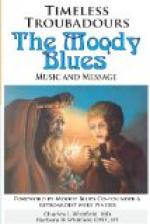melodies are sweet and pleasant: he is master
of his art, if he would but put a little clarity into
his poems, which are difficult to understand.”
The last observation is entirely correct: his
poems are often very obscure. Peire travelled,
in the pursuit of his profession, to the court of
Sancho III. of Castile and made some stay in Spain:
he is also found at the courts of Raimon V. of Toulouse
and, like Peire Rogier, at Narbonne. Among his
poems, two are especially well known. In a love
poem he makes the nightingale his messenger, as Marcabrun
had [68] used the starling and as others used
the swallow or parrot. But in comparison with
Marcabrun, Peire d’Auvergne worked out the idea
with a far more delicate poetical touch. The
other poem is a
sirventes which is of interest
as being the first attempt at literary satire among
the troubadours; the satire is often rather of a personal
than of a literary character; the following quotations
referring to troubadours already named will show Peire’s
ideas of literary criticism. “Peire Rogier
sings of love without restraint and it would befit
him better to carry the psalter in the church or to
bear the lights with the great burning candles.
Guiraut de Bornelh is like a sun-bleached cloth with
his thin miserable song which might suit an old Norman
water-carrier. Bernart de Ventadour is even smaller
than Guiraut de Bornelh by a thumb’s length;
but he had a servant for his father who shot well with
the long bow while his mother tended the furnace.”
The satiric
sirventes soon found imitators:
the Monk of Montaudon produced a similar composition.
Like many other troubadours, Peire ended his life
in a monastery. To this period of his career
probably, belong his religious poems of which we shall
have occasion to speak later.
We have already observed that the Church contributed
members, though with some reluctance, to the ranks
of the troubadours. One of the most [69] striking
figures of the kind is the Monk of Montaudon (1180-1200):
the satirical power of his sirventes attracted
attention, and he gained much wealth at the various
courts which he visited; this he used for the benefit
of his priory. He enjoyed the favour of Philippe
Auguste II. of France, of Richard Coeur de Lion and
of Alfonso II. of Aragon, with that of many smaller
nobles. The biography says of him, “E fo
faitz seigner de la cort del Puoi Santa Maria e de
dar l’esparvier. Lone temps ac la seignoria
de la cort del Puoi, tro que la cortz se perdet.”
“He was made president of the court of Puy Sainte
Marie and of awarding the sparrow-hawk. For a
long time he held the presidency of the court of Puy,
until the court was dissolved.” The troubadour
Richard de Barbezieux refers to this court, which
seems to have been a periodical meeting attended by
the nobles and troubadours of Southern Prance.
Tournaments and poetical contests were held; the sparrow-hawk
or falcon placed on a pole is often mentioned as the
prize awarded to the tournament victor. Tennyson’s
version of the incident in his “Geraint and
Enid” will occur to every reader. The monk’s
reputation must have been considerable to gain him
this position. His love poems are of little importance;
his satire deals with the petty failings of mankind,
for which he had a keen eye and an unsparing and sometimes
cynical [70] tongue.




